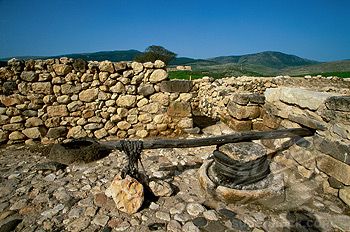7 Amazing Archaeological Discoveries in Israel During 2019
January 3rd 2020
Israel lies in one of the oldest regions of continuous human settlement in the world – the Near East. It’s position between three different continents means the Holy Land has seen the migration and flourishing of countless peoples and civilizations through the millenia. It’s no surprise therefore that every year – every month – there are new amazing archeological discoveries of importance not just to Israel but to the world.
As 2019 comes to a close, we want look back at some of the most interesting archeological discoveries in Israel during the past year.
They include the discovery of:
-
A Watchtower from King Hezekiah’s Time
The 2700- year-old watchtower from the time of biblical King Hezekiah (8th century BCE) was discovered on an Israeli military base near the southern city of Ashkelon. The tower was used as a lookout against the Philistine enemy of the time.
Many of these observation points would have been built between all the major cities, with beacons of smoke or flame being used to convey messages from tower to tower.
-
A 9,000-year-old Neolithic settlement in Jerusalem Valley
The recent discovery of a large Stone Age settlement just outside Jerusalem has unearthed some fascinating insights into the period. The findings are said to change experts’ understanding of Neolithic life including evidence of sophisticated urban planning and farming.
Located near the Israeli town of Motza, the settlement believed to have been inhabited 9,000 years ago, is one of the largest of its kind found in Israel.
-
A staircase at Tel Hazor dating back 3,500 years.
Seven large basalt stairs and a paved entrance hall were recently excavated at Tel Hazor, an archaeological tell at the site of the ancient Hazor. Located north of the Sea of Galilee, near the spiritual city of Safed, the find reveals the grandeur of the Canaanite kingdom which existed 3,500 years ago.
The staircase is unprecedented in its craftsmanship according to archeologists, who hope to find even more stairs on the site in the future. The staircase is now open to public viewing.
-
Neanderthal remains at Ein Qashish
When we think of Neanderthals we often imagine them living in caves and rock structures. However, recent discoveries at the Ein Qashish archaeological site just south of Haifa have revealed they lived in open-air camps according to a paper from Hebrew University Institute of Archaeology.
Neanderthals settled in northern Israel for about 10,000 years during the Paleolithic era, 50,000 years ago.
-
City of David Pilgrimage Road
A new discovery in Jerusalem’s City of David has got archeologists and historians very excited. A 2,000-year-old pilgrimage road which goes from the Shiloah Pool to an area adjacent to the Western Wall is believed to be an ancient road millions of Jewish pilgrims would have taken during Judaism’s three key holidays.
Only 250 meters of the road have so far been excavated but more will soon be revealed, in what is said to be a discovery that will change the way Jews connect with their past.
-
A table where Ark of the Covenant once sat
A stone table, recently excavated inside a 3,100-year-old temple uncovered near Beit Shemesh, might potentially be the site where the Ark of the Covenant once sat. Discovered 20km west of Jerusalem, the huge dolmen-like rock slab table ties in with the timeframe of the Ark narrative.
However, experts have said it’s impossible to prove archaeologically whether it is in fact the Ark or not.
-
A 2000-year-old Roman fish sauce factory
The Israel Antiquities Authority recently discovered an ancient Roman factory on the site of a planned sports park on the outskirts of the southern city of Ashkelon. The 2,000-year-old factory made garum, a popular fermented fish sauce among Romans.
The production of the sauce gave off such a pungent odor that the factories had to be located some distance from the ancient cities they served.












